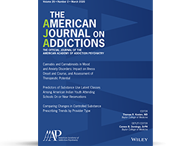Addiction Psychiatrists from AAAP, several who are also boarded in forensics, have been working with the Opioid Response Network to create resources for the justice community to better address the alarming increase in substance use disorders with an emphasis on overdoses related to the opioid epidemic and rising stimulant use.
AAAP, working with the National Judicial Opioid Task Force, the Conference of Chief Justices, and the Conference of State Court Administrators, have developed a resource guide—Cultivating Law and Medicine Partnerships to Support Justice-Involved Individuals with Substance Use Disorders—as well as an online 8-module course. Both resources are available at no cost and are intended to give the justice community a stronger understanding of the medical aspects of these disorders and the evidence-based prevention and treatment needed to address them to be effective.

Access the Free Digital Guide
Cultivating Law and Medicine Partnerships to Support Justice-Involved Individuals With Substance Use Disorders
With the alarming increase in fatal and non-fatal overdoses related to the opioid epidemic and the rising rates of stimulant use, the need for cross-system collaboration and the development of partnerships between justice and medical professionals has never been greater.
FAQ Highlights
Opinions in the medical community differ on this question, particularly as it pertains to certain populations. Generally, for treatment-seeking individuals, buprenorphine is thought to have minimal cognitive impairment compared to methadone. For certain groups, such as physicians or pilots, the concern about cognitive impairment is higher based upon the safety-sensitive nature of their professions, so some clinicians recommend naltrexone for individuals in safety-sensitive occupations.
No. Although some people believe this to be true, the use of buprenorphine, naltrexone and methadone is much different than the use of illicit drugs. Medical professionals have extensive training in the assessment of individuals with OUD and particularly in the pharmacology of buprenorphine, naltrexone and methadone. Medical professionals are familiar with dosing, side effects, and interactions with other drugs, and prescribe the medication specifically for the individual. Furthermore, when buprenorphine, naltrexone or methadone are obtained from a legitimate source, such as a pharmacy or an outpatient treatment program, one is assured of the composition of that medication, unlike the purchase of substances on the street. As many people are aware, illicit pills are produced to look like a particular product but may contain deadly ingredients, such as fentanyl or carfentanyl. Also, individuals receiving treatment with buprenorphine, naltrexone or methadone do not place themselves in risky situations obtaining them, as often happens with the purchase of illicit drugs. There are many other differences, but these are the key differences and collectively represent a healthier lifestyle.
View more FAQs
The Disease Process and Addressing Substance Use Disorders Course
This course is intended for judges, all individuals working within justice systems, and justice system stakeholders who may interface with individuals with substance use disorders (SUDs) including opioids, stimulants, and polysubstance use disorders and with co-occurring psychiatric disorders.
The Opioid Response Network is a SAMHSA grant initiative, led by AAAP working collaboratively with the Addiction Technology Transfer Center Network, at the University of Missouri – Kansas City, Columbia University Division on Substance Use Disorders and 40 national organizations. The Oioid Response Network provides education and training in the prevention, treatment and recovery of opioid and stimulant use disorders at the local level via its network of consultants in every state and territory – all at no cost.



